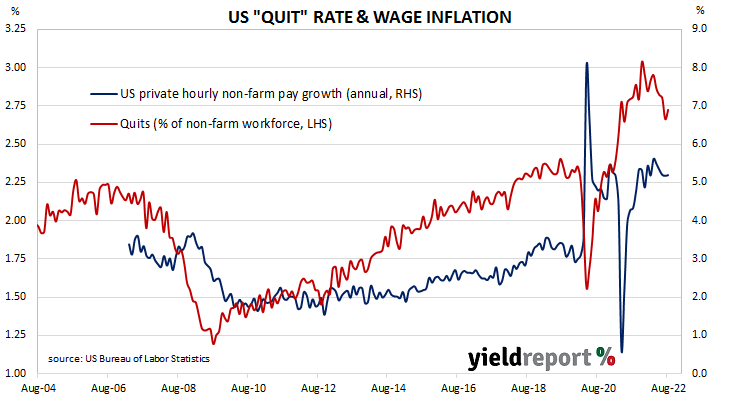Summary: US quit rate steady at 2.7% in August; US bond yields fall substantially, expectations of higher rates firm; “first meaningful sign” of cracks in labour market; quits, separations up, openings down.
The number of US employees who quit their jobs as a percentage of total employment increased slowly but steadily after the GFC. It peaked in March 2019 and then tracked sideways until virus containment measures were introduced in March 2020. The quit rate then plummeted as alternative employment opportunities rapidly dried up. Following the easing of US pandemic restrictions, it proceeded to recover back to its pre-pandemic rate in the third quarter of 2020 and trended higher through 2021 before easing in the first half of 2022.
Figures released as part of the most recent Job Openings and Labor Turnover Survey (JOLTS) report show the quit rate remained steady in August. 2.7% of the non-farm workforce left their jobs voluntarily, unchanged from July, as quits rose by 100,000 and an additional 315,000 people were employed in non-farm sectors.
US Treasury yields finished the day substantially lower. By the close of business, the 2-year Treasury bond yield had shed 21bps to 4.01%, the 10-year yield had lost 23bps to 3.58% while the 30-year yield finished 12bps lower at 3.65%.
In terms of US Fed policy, expectations of higher federal funds rates over the next 12 months firmed slightly. At the close of business, November contracts implied an effective federal funds rate of 3.725%, 65bps higher than the current spot rate while December contracts implied a rate of 4.035%. September 2023 futures contracts implied 4.32%, 134bps above the spot rate.
The rise in total quits was led by 119,000 more resignations in the “Accommodation and food services” sector while the “Professional and business services” sector experienced the largest fall, decreasing by 98,000. Overall, the total number of quits for the month rose from July’s revised figure of 4.058 million to 4.158 million.
Total vacancies at the end of August dropped by 1.117 million, or 10.0%, from July’s revised figure of 11.170 million to 10.053 million. The fall was driven by a 236,000 decrease in the “Health care and social assistance” sector and a 183,000 fall in the “Other services” sector while the “Construction” sector experienced the single largest increase, rising by 54,000. Overall, 14 out of 18 sectors experienced fewer job openings than in the previous month.
NAB Head of FX Strategy, Ray Attrill, described the fall as ”the first meaningful sign of some cracks in the labour market.” However, he also said “the absolute levels are still consistent with a very tight labour market…” He noted “the Fed will undoubtedly welcome the tentative signs of easing demand for labour.”
Total separations increased by 182,000, or 3.1%, from July’s revised figure of 5.794 million to 5.976 million. The rise was led by the “Accommodation and food services” sector where there were 175,000 more separations than in July. Separations increased in 11 out of 18 sectors.
The “quit” rate time series produced by the JOLTS report is a leading indicator of US hourly pay. As wages account for around 55% of a product’s or service’s price in the US, wage inflation and overall inflation rates tend to be closely related. Former Federal Reserve chief and current Treasury Secretary Janet Yellen was known to pay close attention to it.


